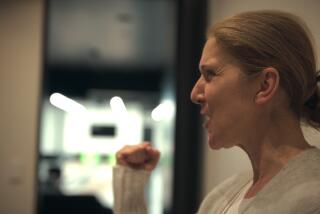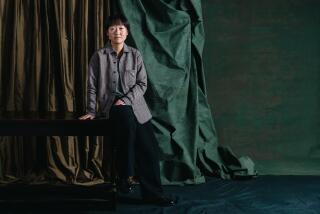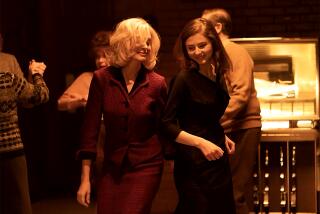The Exile of Celine<i> by Tom Clark (Random House: $16.95; 214 pp.)</i>
- Share via
In 1944, Louis-Ferdinand Celine, French novelist, doctor, anti-Semite, Fascist collaborator and world traveler, arrived in the waiting room of hell. Gathered to meet him at the train station in Sigmaringen, Germany, were members of the Vichy government in exile. Ghosts vanishing at first light, the underlings of Petain and Laval were fading into the landscape of horror they had helped to create. Celine went to Germany as doctor to the dead.
In the company of his wife and pet cat, Celine took up residence in a Hohenzollern castle. He wandered the dark halls, treating the flabby, flatulent Vichyists with morphine injections and nitroglycerin pills; dispensing stupor and release to bodies suddenly aware that the skull on their uniform might be their own. One night, during a formal dinner, Celine castigated his hosts. The SS was not amused. Clearly, it was time to go.
Celine had arrived in Germany with 20 trunks of belongings. He left Germany with a rucksack. Midnight had finally got around to him. Clutching one of the last exit visas, he fled north by train, crossing bomb-shattered Germany on his way to Copenhagen. In Denmark, Celine lived a brief parenthesis of peace before being arrested and imprisoned for his collaborationist activities and macabre diatribes against the Jews.
Broken in body and frayed in spirit, Celine was finally released and returned to France to stand trial. Capitalizing on his World War I heroism and time spent in a Danish prison, he was pardoned and exiled to the suburbs of Paris, where, amid the diseases of the poor, he sat down and wrote “Castle to Castle,” “North” and “Rigadoon,” a trilogy on the history of hell--his.
Across this ghastly terrain, Tom Clark has fashioned his novel. As a poet, Clark knows which images to experience; as a biographer, he understands which experiences to imagine. In “The Exi1818566767reality of Celine that Celine himself realized as fiction in his books of exile.
Clark has courage. He has rewritten the experience of one of the masters of 20th-Century French prose. Thus, in reading “The Exile of Celine,” the reader has three visions superimposed before his eyes: that of Tom Clark’s novel, that of Celine’s lived experience, and that of Celine’s own three fictions. One wonders what Clark can add to Celine’s tales. How can Clark avoid being accused of the worst kind of vicariousness: drawing his ink from the well of someone else’s suffering?
Clark’s motive for entering the world of the French writer is to be “a companion of the abyss.” But what kind of creation is at hand when an artist who traversed the slopes of horror now finds himself a character repeating the same dark transit in a novel other than his own? Also, what difference does it make in a journey of suffering if the surrounding destruction was caused by men like the character stumbling over the detritus?
The Celine of Clark’s novel is harried and hounded by the very sky itself. Yet the anti-Semite Celine, where is he? We see a man fleeing; we follow, but because of Clark’s power of descript1768910380fleeing from something he did or from something done to him. We hurry along in the frightened footsteps of a man running in terror, only to have him finally stop, turn and reveal the rictus of Satan.
Clark shadows Celine--stops where he stopped, sees what he saw, but with a difference. Clark’s embers were Celine’s flames. What Celine wrote in the language of nightmares, Clark retells in the language of dreams.
A strong poet, Clark is able to lower and raise the temperature of his writing from Antarctica to the surface of the sun, yet he can only hold up a bowl of darkness beside Celine’s ocean of night.
How can Clark invest Celine’s smoldering fresco with the shock, terror and horror that Celine bled into it? He can’t. He can rely on images to connote and convey disaster, but war is, like the world beyond the shadows of Plato’s cave, something man must go out to see.
Clark’s Celine is a Doppelganger. He follows Celine’s own initial character but is diminished in mood, intensity and speed of perception. Clark’s eye can be blindingly precise: “Celine saw Denmark like a glacier in which he was permanently immured as some prehistoric fossil.” But he can falter, too: “The minutes went by like slow boats carrying a crew of banshees across an ocean with no shores.” Here the image has greater resonance than the reality it evokes.
Writing a novel in images is like trying to hold together the shards of a mirror: The parts are not the sum total of the whole; they are evidence of its absence. Adjectives for hell do not release sulfur. One must be taken down, word by word, step by step. Clark leads the reader all the way--to the furnace door.
Celine stands on the other side.
More to Read
Sign up for our Book Club newsletter
Get the latest news, events and more from the Los Angeles Times Book Club, and help us get L.A. reading and talking.
You may occasionally receive promotional content from the Los Angeles Times.







